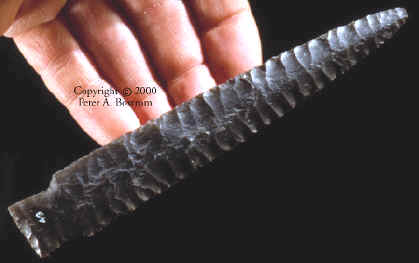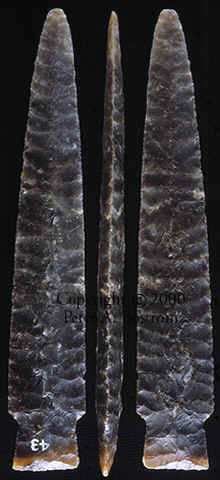|
TYPE II
SCOTTSBLUFF
POINT
BEAVERHEAD CO.,
MONTANA
7000 TO
6000 B.C.
FORREST FENN
COLLECTION

CAST #P-5
TYPE II
SCOTTSBLUFF
POINT
BEAVERHEAD CO.,
MONTANA
FORREST FENN
COLLECTION
This Scottsbluff point was found in southwestern Montana in 1895 in a gold
miners sluice box. Of its six previous owners, the second individual, A. Dr.
Frank Linderman, wrote "It was found by a placer miner at considerable
depth near Red Rock Lake, Montana in 1895. This prospector gave it to me in
a saloon in Dillon, Montana in 1896". Virgil Russell purchased it in
1945 and wrote, "this is probably one of the finest Yumas ever
found". Yuma was a name used in earlier years for several different
types of Cody complex points.
SCOTTSBLUFF
POINTS
Scottsbluff points were named by
C.B. Schultz and E.H. Barbour
in 1932 for points of this style found with the bones of extinct bison near
Scottsbluff, Nebraska. (Wormington 1957:118).
Scottsbluff points have a wide distribution area. They are
found in west central Canada and the Rocky Mountains as far northeastward as
Wisconsin and as far south as northwestern Louisiana, southwestern Arkansas,
Texas and Oklahoma. (Perino 1985:348)
There are two main types of Scottsbluff points plus one lesser
variation in Wisconsin. Type I points possess triangular or parallel-sided
blades with weak shoulders and broad stems. Flaking is usually a transverse
parallel style but can also be irregular. Type II points are nearly the same
as Type I except they have wider triangular blades and have thin lenticular
cross sections with more clearly defined shoulders. The type III has slight
basal ears on some specimens in Wisconsin. (Justice 1987:46,47)
Scottsbluff points are diagnostic of the cody complex in the
plains along with Eden points and Cody Knives. A single Scottsbluff point
was stratigraphically the deepest diagnostic artifact in the Cody complex
zone at the Claypool site in Colorado, where a series of Eden points and
Cody knives were found. (Justice 1987:47)
Scottsbluff
points belong to the Cody phase approximately 8,000 to 9,000 years ago
along with Eden points and Cody Knives. These people were Plano hunters
who lived on the western plains and hunted the next largest living
animals, after the megafana had disappeared, the bison. They hunted by
"drive-hunting" where large numbers of animals were driven into
box canyons or ravines where they could be trapped and killed.
|

